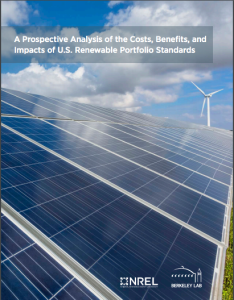Full Title: A Prospective Analysis of the Costs, Benefits, and Impacts of U.S. Renewable Portfolio Standards
Author(s): Mai T, Wiser R, Barbose G, Bird L, Heeter J, Keyser D, Krishnan V, Macknick J, Millstein D
Publisher(s): National Renewable Energy Laboratory, Lawrence Berkeley National Laboratory
Publication Date: January 1, 2017
Full Text: Download Resource
Description (excerpt):
This is one report in a series that explores the costs, benefits, and other impacts of state renewable portfolio standards (RPS), both retrospectively and prospectively. The first report, A Survey of State-Level Cost and Benefit Estimates of Renewable Portfolio Standards, published in 2014, comprehensively summarized historical RPS compliance costs, drawing in part on estimates developed by utilities and state regulatory agencies. The study also reviewed analyses of the broader societal benefits and impacts of several states’ RPS policies, typically conducted for or by the regulatory agencies or RPS administrators in those states. However, the small number of such studies, and their widely varying methods and scopes, ultimately limited the ability to compare benefits across states or to generalize beyond the specific studies performed. That limitation set the stage for future reports.
The second report in the series, A Retrospective Analysis of the Benefits and Impacts of U.S. Renewable Portfolio Standards, published in January 2016, analyzed historical benefits and impacts of renewable energy (RE) used to meet all state RPS policies, in aggregate, employing a consistent and well-vetted set of methods and data sets. The analysis focuses on three specific benefits: air pollution, greenhouse gas emissions, and water use. It also analyzes three other impacts: gross job additions, wholesale electricity market price suppression, and natural gas price suppression. These are an important subset, but by no means a comprehensive set, of all possible effects associated with RPS policies. That report did not include a comparison of costs and benefits of renewables used to meet RPS policies, and nor did it assess the potential costs, benefits, and impacts prospectively based on future increases in RPS targets.
The present report fills that gap by evaluating the future costs, benefits, and other impacts of renewable energy used to meet current state RPS policies. It also examines a future scenario where RPSs are expanded. The analysis examines changes in electric system costs and retail electricity prices, which include all fixed and operating costs, including capital costs for all renewable, non-renewable, and supporting (e.g., transmission and storage) electric sector infrastructure; fossil fuel, uranium, and biomass fuel costs; and plant operations and maintenance expenditures. The analysis uses the same framework as the second report to analyze three specific benefits: air pollution, greenhouse gas emissions, and water use. It also analyzes two other impacts, RE workforce and economic development, and natural gas price suppression.
